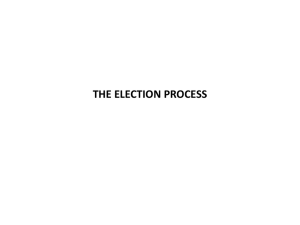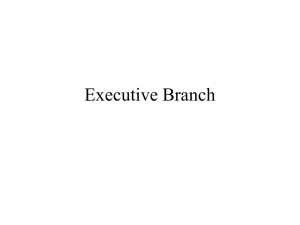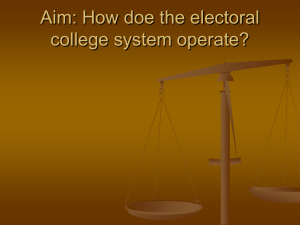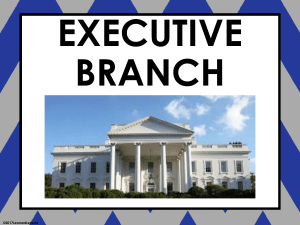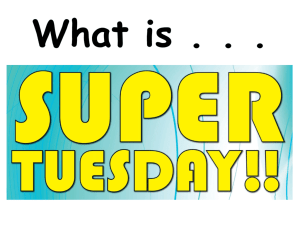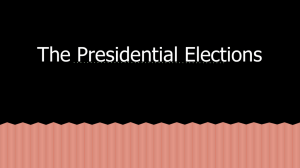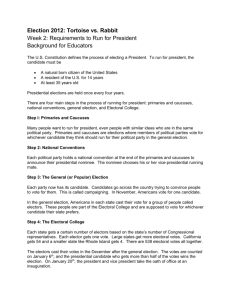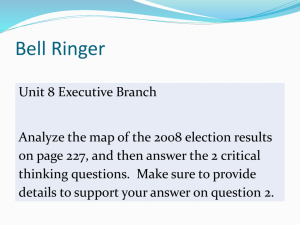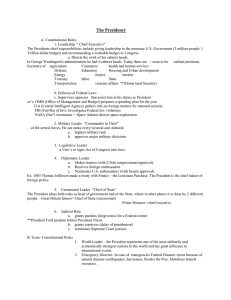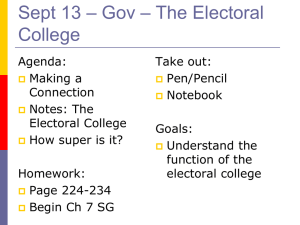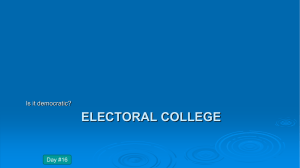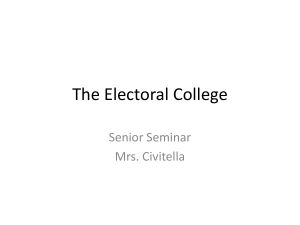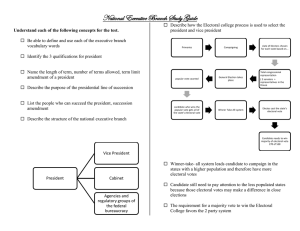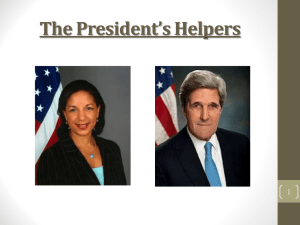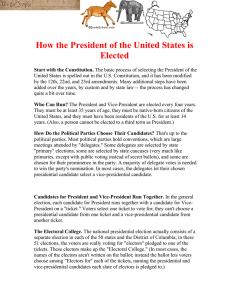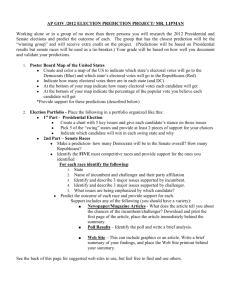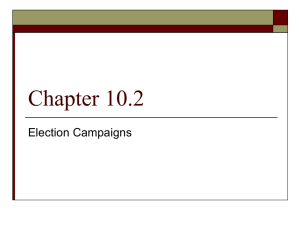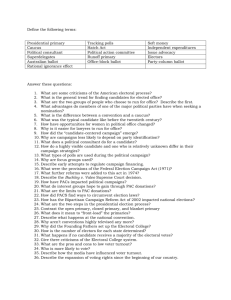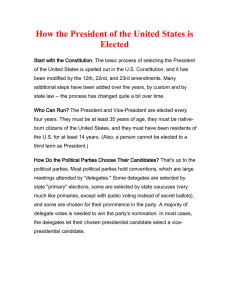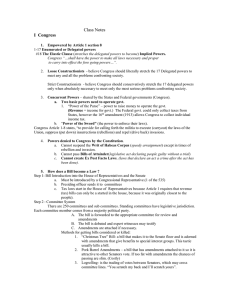Unit 10: Executive Branch
advertisement
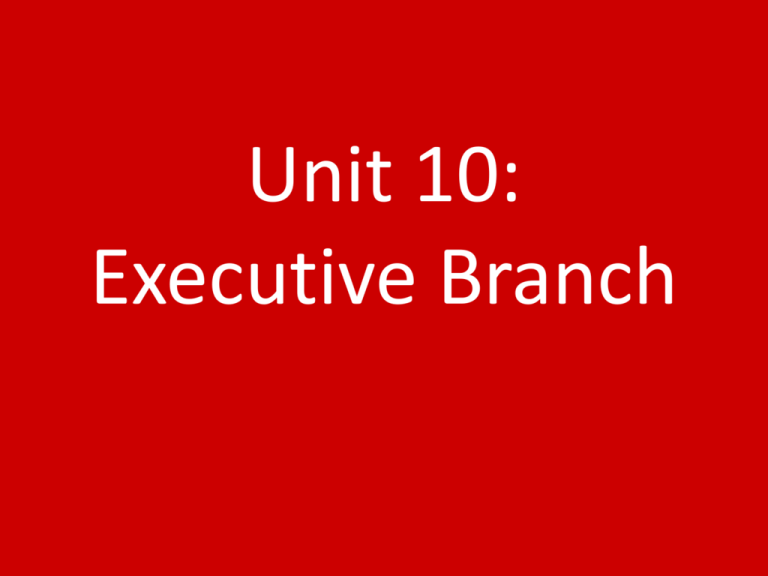
Unit 10: Executive Branch • Enforces Laws • Article II of the Constitution • Led by the President of the United States. • All but one president have been white males. All but one has been Protestant. • President Video Cabinet: Group of advisors to the president. Cabinet • The pres. chooses the head of each agency – Each leader is called “secretary” except for the leader of the Department of Justice (Attorney General) • Senate must confirm. • pg 227 Qualifications • Must be a native-born US citizen. • Must be 35 years old. • Must have lived in the United States for 14 years. • The president is elected every four years by the Electoral College. – 2 term limit (22nd Amendment) Electing the President 1. The Primaries – States hold primary elections to vote for the candidates who will run for president under each party 2. Nominating Conventions – A meeting held by each party to officially select the candidate who will run 3. General Election – 1st Tuesday after the 1st Monday of November 4. Electoral College – Elects the President in December Electoral College • # of Representatives + # of Senators = Electoral College Members • After the Nominating Conventions choose 2 candidates, each candidate goes to every state to choose “electors” – Electors are members of the state legislature who are of the same political party as the candidate • Electors promise to vote for the candidate if they win the majority of the popular vote in that state – For example: NC has 15 Electoral College votes (13 Reps + 2 Sen), so Obama will come to NC and choose 15 Democrats from our state legislature to be his electors. The Republican candidate will also come to our state and choose 15 Republicans to be their electors. If Obama wins the majority of the votes in NC, the 15 Democrats will go to Washington DC to vote in the Electoral College. If the Republican candidate wins in NC, only the 15 Republicans will go. - 538 total electors - 270 votes needed to win - “Big Four” = CA, TX, NY, FL - “Winner take all” system Problems With the Electoral College • Seems non-democratic – Everyone’s vote does not count the same • May get the most votes in the whole country, but still lose the election • 3rd party candidates have really no chance Benefits for President • Salary of $400,000. The salary is set by Congress. • Live in the White House. Unlimited use of Camp David (Maryland). • Good medical benefits and protection. • Many assistants. Vice President • Qualifications are the same as the pres. • Salary of $230,700, free residence at the Naval Observatory, and personal assistants. • 2nd in line of succession Succession • According to the 25th amendment, the VP takes over if the president can not fulfill his duties for any reason. • The presidential line of succession provides a lay out of who would be president in many cases. 8 Hats of the President 1. 2. 3. 4. 5. 6. 7. 8. Chief Executive Judicial Leader Legislative Leader Chief of State Commander in Chief Chief Diplomat Party Leader Economic Leader In Your Group… • Use your textbook/internet to research your assigned topic & vocab • http://www.scholastic.com/teachers/article/seven-roles-one-president – Your hat should have a title on the brim (on smooth side) – On the smooth side of the hat, give a short job description and an illustration symbolizing this job – On the other brim, give a few specific examples of the president doing this job – On the folded flaps, define any vocab assigned to you Roles of the President 1. Chief Executive: Leader of the federal bureaucracy and its many agencies – Executive Order: a command that has the force of law. – The president appoints many officials • must be approved by the Senate. 2. Legislative leader: signs bills into laws – The president needs to get along with Congress so they can both be effective Roles of the President continued… 3. Judicial leader: Appoints judges that serve for life. – The president can pardon an individual or give amnesty to a group. • Pardon: forgiveness from punishment – The President can reprieve, delay punishment until a higher court rules. Roles of the President continued… 4. Party leader: The president helps other party members get elected (coattail effect). – Appoints people with his views. 5. Commander in Chief: Only the President can order troops into battle. – Congress is given the power to declare war. Roles of the President continued… 6. Chief Diplomat: Appoints ambassadors and makes treaties. – Ambassador: Official representative to a country. – Treaty: Agreement between two or more countries. Must be approved by the Senate by a 2/3 majority. – Executive Agreement: Agreement between the president and the leader of another country. Does not require Senate approval. • Embargo: refusal to trade with a country – ie Cuba Roles of the President continued… 7. Chief of State: The president represents the entire nation. – Acts as the symbolic leader of the United States. – People are very interested in the president and his family. Roles of the President continued… 8. Economic Leader: Deals with problems in the economy like unemployment, inflation, and taxes. – In charge of creating the federal government’s budget for each fiscal year.

